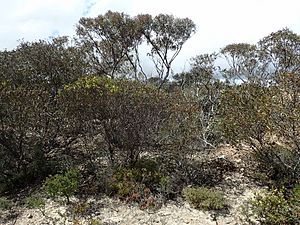Red-capped mallee facts for kids
Quick facts for kids Red-capped mallee |
|
|---|---|
 |
|
| Eucalyptus dissimulata near the Fitzgerald River National Park | |
| Scientific classification | |
| Genus: |
Eucalyptus
|
| Species: |
dissimulata
|
The Red-capped Mallee (Eucalyptus dissimulata) is a special type of tree or shrub found only in Western Australia. It's called a "mallee" because it usually has many stems growing from the ground. This plant has smooth, greyish bark that peels off in strips. Its adult leaves are shiny green and shaped like narrow ovals or spears. The flowers are creamy white and grow in groups of seven to eleven buds. After flowering, it produces small, woody fruits that look like short barrels.
Contents
About the Red-capped Mallee
The Red-capped Mallee is a type of mallee plant that usually grows to be about 1 to 6 meters (3 to 20 feet) tall. It has a special woody swelling at its base called a lignotuber. This lignotuber helps the plant regrow if it gets damaged, for example, by a bushfire.
Its bark is smooth and can be light grey or greenish-brown. It often peels off in long strips. Young plants and new shoots have leaves that grow directly from the stem without a stalk, arranged in pairs. These leaves are about 2.5 to 4.5 centimeters (1 to 1.8 inches) long and 1 to 1.5 centimeters (0.4 to 0.6 inches) wide.
Adult leaves are shiny green and grow in an alternating pattern along the stem. They are narrow and shaped like an ellipse or a spear, measuring about 4.5 to 9.5 centimeters (1.8 to 3.7 inches) long and 0.5 to 1.7 centimeters (0.2 to 0.7 inches) wide. Each leaf has a stalk, called a petiole, which is about 0.5 to 1.8 centimeters (0.2 to 0.7 inches) long.
Flowers and Fruit
The flower buds of the Red-capped Mallee grow in groups of seven, nine, or eleven. These groups are found in the axil (the angle between a leaf and the stem). Each group of buds sits on a stem called a peduncle, which is about 0.5 to 2 centimeters (0.2 to 0.8 inches) long. Each individual bud has its own small stalk, called a pedicel, about 0.1 to 0.5 centimeters (0.04 to 0.2 inches) long.
When the buds are ready to open, they are oval or diamond-shaped, about 0.7 to 1.2 centimeters (0.3 to 0.5 inches) long and 0.4 to 0.5 centimeters (0.16 to 0.2 inches) wide. They have a cone-shaped cap, called an operculum, which is about 0.3 to 0.5 centimeters (0.12 to 0.2 inches) long.
The Red-capped Mallee blooms between October and March, producing creamy white flowers. After the flowers, the plant develops woody fruits. These fruits are like small, short cylinders or barrel shapes, about 0.5 to 0.7 centimeters (0.2 to 0.3 inches) long and 0.5 to 0.8 centimeters (0.2 to 0.3 inches) wide. Inside, the seeds are brown-grey and have a flattened oval shape.
Naming the Red-capped Mallee
The scientific name for this plant, Eucalyptus dissimulata, was first officially described by a botanist named Ian Brooker in 1988. He wrote about it in a science journal called Nuytsia. Brooker found the plant in 1984, about 30 kilometers (19 miles) north of Needilup.
The second part of its scientific name, dissimulata, comes from a Latin word that means "pretending." This name was chosen because the Red-capped Mallee looks a lot like another eucalyptus species called E. albida, almost as if it's pretending to be it!
This species belongs to a large group of eucalyptus trees called Eucalyptus subgenus Symphyomyrtus.
Where it Lives
The Red-capped Mallee is found only in a specific part of Western Australia. It grows along a narrow strip near the coast, in areas known as the Wheatbelt and Goldfields-Esperance regions. You can find it between the towns of Corrigin and Munglinup. It prefers to grow in sandy or loamy soils, often on sand-plains or near creeks.
Conservation Status
The Western Australian Government's Department of Parks and Wildlife has classified Eucalyptus dissimulata as "not threatened." This means that, for now, there are enough of these plants in the wild, and they are not considered to be at risk of disappearing.
Images for kids



